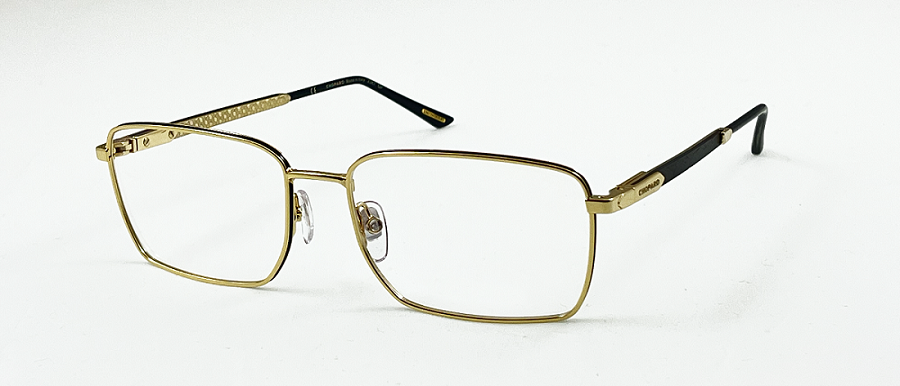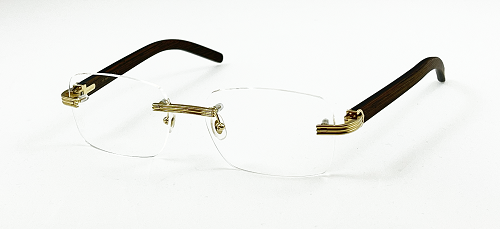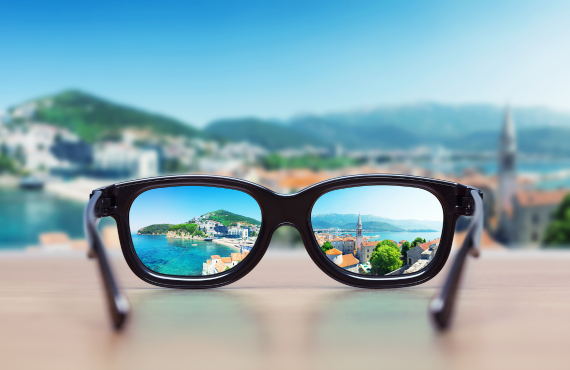Introduction
Do you know? The crystalline or the natural internal lens of our eyes is surrounded by the tiny fibers, known as ciliary muscles, that contract to help us focus on an object. However, these muscles begin to weaken as we age and lose their ability to focus properly. This condition is referred to as Presbyopia.
Usually, people start noticing the change in the ability to focus around the age of forty and have difficulty performing everyday tasks such as using a computer, reading, etc. This is where they need corrective lenses in order to focus on the objects properly from different distances. There are a number of spectacle lens options available to manage this issue. The most common of these are:
- Single vision Reading or Near Vision spectacles
- Bifocal spectacles
- Progressive Lenses
Out of these Progressive Lenses are the most popular and appropriate option for today’s active lifestyles. But to know about what makes progressive lenses so popular and useful than the other lenses, please read this blog until the end. Here, we will discuss the following: -
- What are progressive lenses?
- Progressive lens benefits
- Disadvantages of progressive lens
- Progressive lens price in India
- Types of progressive lens
- Bifocal vs Progressive lenses
What are Progressive Lenses?

Progressive lenses, also known as no-line bifocals are actually more than just bifocals. These are effectively multifocal lenses but unlike multifocal lenses, there are no dividing lines in progressive lenses. As the name suggests, progressive lenses have continuous, seamless progression of power from distance vision correction to near vision correction. These corrective lenses are used to correct the eye condition called Presbyopia or the “ageing vision”.
Progressive lenses provide the required correction to presbyopic patients to help them see clearly, irrespective of the viewing distances. In addition to that, progressive lenses also help you avoid the discontinuities, like image jumps, etc., that are sometimes found with bifocal and trifocal or multifocal lenses that have dividing lines between different focal zones.
Advantages of Progressive lens
As discussed above, progressive lenses are primarily used to improve vision-related problems like astigmatism and Presbyopia. But, along with correcting the vision problems, there are various other advantages of these lenses. Let’s go through a few of the major progressive lenses benefits: -
- Needs one pair of eyeglasses
Progressive lenses come with multiple prescriptions for varying focusing distances like distance vision, near vision, and mid distances like computers, office desks, kitchen work, etc in one pair of spectacles. Therefore, it is better than separate single-vision spectacles for distance and reading as progressive lenses enable you to see clearly at different distances without any need to carry multiple separate pairs of eyeglasses.
- Better aesthetics with No Line appearance
With progressive lenses, you get the advantages of a multifocal lens without a demarcating or dividing line between different focal zones. In addition to that, there is a continuous shift in the power of the lens. Therefore, you do not have to go through the sudden shift in focus that people face with bifocal or trifocal lenses. Hence, you get all the benefits in a single pair of glasses.
- Looks youthful and stylish
Bifocal or trifocal eyeglasses are often associated with old age. Therefore, eyeglasses having a bifocal line may make you look a little old and self-conscious. On the other hand, with a progressive lens, you do not see any visible line on the lens that makes it look just like a regular pair of single vision spectacles and hence, more attractive and youthful.
Disadvantages of Progressive lens
Along with many benefits like “no-line” visual clarity, progressive lenses also have disadvantages. Therefore, to have a clear understanding of the progressive lenses, let’s go through their disadvantages: -
- Have to learn to see through the lenses
Like with any bifocal or multifocal lenses, progressive lenses too have a learning curve. One has to learn to identify which part of the lens is distance and how to access the near vision power and focus for varying distances by moving the eyes across the lens. However, the good part is that, since the shift in power is continuous and seamless, progressive lenses are easier to adapt to than traditional bifocals or trifocals.
- May cause peripheral “swim effect”
While moving your eyes from one side to another, progressive lenses can cause a “swim effect” in the periphery. However, gradually, your eyes become habitual and adjust to the lenses, and such effects become less noticeable. Opting for more advanced and digital progressive lens designs can reduce the swim effect greatly. At R. Kumar, we offer you great value for money digital progressive lens designs even at entry-level prices to help you adapt to progressive spectacles easily.
- Costlier than single-vision or bifocal lenses
Progressive lenses are specialized spectacle lenses and the technology involved is typically more advanced than single vision or bifocal lenses. Hence, the cost is more but the benefits clearly outweigh the cost. Hence, the benefits of a progressive lens make it totally worth the extra cost.
Types of Progressive lens

In this section of the blog, we will discuss the five major types of progressive lenses that will help you in choosing the most suitable one for yourself: -
1. Standard Progressive lenses
Standard progressive lenses are the regular progressive lenses that provide a standard reading area. However, they are less specialized than the other types of lenses. These progressive lenses are comparatively affordable.
The only major disadvantage of the standard progressive lens is it may not work for extensive desk work.
2. Digital Progressive Lenses
Digital progressive lenses are advanced versions of progressive lenses processed by cutting-edge digital processing technologies. The major advantage of digital lenses is better zones of clear vision. This leads to easier-to-adapt progressive lenses. Most first-time users adapt to digital progressive lenses almost instantly. At R. Kumar, the first choice offered to most progressive lens seekers is a digital progressive lens. By making it the default choice for most cases, we have been able to leverage the economy of scales to make digital progressive lenses available at almost the same cost as standard options so the new technology is accessible to everyone.
3. Short Corridor Progressive Lenses
This type of progressive lens is specially designed for smaller frames. It is a myth that the short corridor progressive lens cost is a little higher than the cost of the standard progressive lens and that initially, you can find it a little difficult to adapt to these lenses. Today, with smart digital technology, short corridor progressive lenses can be adapted to most frame sizes and are just as easy to adapt. Moreover, if you want to know about the best progressive lens price in India, please visit R Kumar Opticians. They offer high-quality lenses made by skilled professionals at the most reasonable prices.
4. Home and Office or Extended Near Vision Lenses
In general, we do not recommend progressive lenses for people who use desktops or computer screens at the level of their eyes. For such busy office users and for home makers who mostly work at shorter viewing distances spread across one hand’s distance to 3 feet, we recommend a specialized version of progressive lenses designed to work for this specific range. They are specially designed to provide you with clear vision at the range of around 16 inches to 3 feet.
As the name suggests, these lenses are an ideal option for all those who have spent most of their time working on the desktop where the computer screen is at eye level. These are also great for architects, artists, painters, and sculptors who work for long hours across a desk. Due to this, they are also known as “office lenses” or “near variable focus lenses.”
5. Personalised or Customised Progressive Lenses
Truth be told, there is always a level of customization in each pair of progressive lenses. An optometrist has to mark the individual eye’s pupillary distance and progressive height on each frame. In personalized progressive lenses, we map many more parameters with regards to the frame wrap, pantoscopic angle, and the head-eye movement of each individual to personalize the design of the progressive lenses to each client and each frame. The result is an easier-to-adapt pair of progressive lenses.
We use “free-form design”, “wavefront technology,” and other technologies often patented by big brands like Varilux, Nikon, and Zeiss, among others to bring to you the most maximized vision comfort for your lens prescription. Such premium progressive lenses offer a much wider as well as distortion-free reading area. One of the major advantages of this type of progressive lens is it can be custom designed to fit into your chosen eyeglass frame, prescription, and eye anatomy. However, premium progressive lenses are a little expensive compared to the price of the lenses we discussed above.
Which is better: Progressive or Bifocal Lenses?
Before analyzing which is a better option among progressive and bifocal lenses, you must know the basic difference between the two.
Difference between progressive and bifocal lenses
- As discussed in the above sections, progressive lenses do not have lines and look like single-vision lenses but enable you to see clearly at all distances. On the other hand, bifocal lenses have lines that separate two different prescriptions.
- Bifocal lenses come with a distance prescription on top, whereas the reading prescription at the bottom helps the user view nearby objects.
Bifocal vs Progressive Lenses: which is better?
Both types of lenses have their advantages and disadvantages. Therefore, it is important to know your lifestyle and requirements to decide which lens is better for you. Both the lenses take a few days to adjust. Moreover, you must consider the below points while choosing the best option for you: -
- Progressive lenses enable you to see at varying distances clearly and do not have lines on them.
- Bifocal lenses have lines and allow you to see clearly from two distances.
To sum up, progressive lenses are suitable for most lifestyles and appropriate for all lifestyles including that of an active person to a home-maker. Especially in today’s times when lifestyles have a huge component of digital (mobile / tablet) based entertainment (netflix, youtube, and all), education, and communication (texts and video calls), progressive lenses are the best vision solution for varying screen sizes and distances.
Bifocals can be called for in case of budgetary constraints and when the user is specific about two working distances only.

Share:
Contact Lens - All you need to know